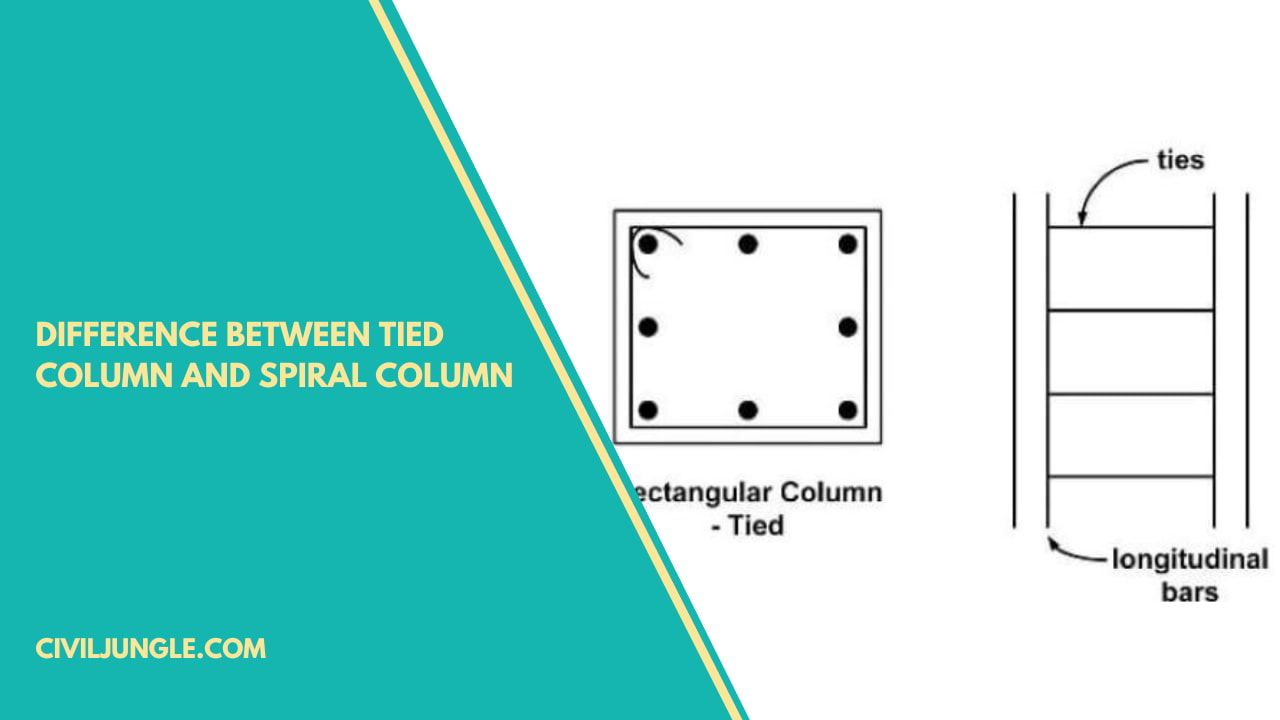
Introduction of Column
The column is one of the most important component parts of the structure. The main function of the column is to transfer the whole load of the structure to the underground strata.
Columns are constructed to support axial compressive loads of the structure. The columns are classified according to how they are reinforced into the spirally and tied reinforced columns. In this article, you will get to know about the difference between tied column and spiral column.
What Is Spiral Column?

Spiral columns are cylindrical in the shape with the continuous helical bars which are wrapped around the column.
The reinforcement which is used in the spiral column is also known as helical reinforcement or spiral reinforcement. The Spiral reinforcement helps to support in the transverse direction.
In the case of spiral column, the lateral expansion of the concrete is restrained by the spiral. Generally, spiral columns are adopted when ductility is important for or where high loads make it economical to utilize the extra strength.
Spiral columns have spirals to hold the main longitudinal reinforcement in its position and to increase the column ductility before failure.
The spiral columns undergo a marked yielding which is followed by the deformation before the complete failure. Spiral columns give an indication before their failure so that certain measures can be taken.
Spiral Reinforcement
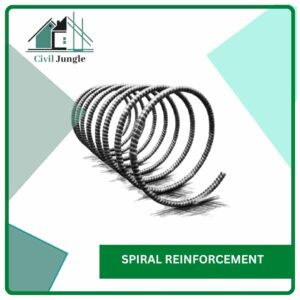
- There is six number of minimum reinforcement bars should be used in case of spiral column. The diameter of the bar which is used in the spiral column should not be less than 12 mm and the maximum distance between the longitudinal bars should not be more than 300 mm.
- When the transverse reinforcement it is used in the form of helical hoops then it is known as spirally reinforced column.
- The longitudinal reinforcement bars are arranged in the spiral column by a closely spaced continuous spiral.
- The spiral columns are usually circular in shape. Spiral reinforcement should be held firmly at its place and true to the line.
Spiral Brick Column
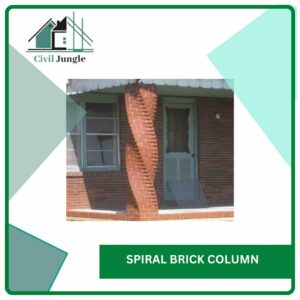
- The spiral brick column is a special type of column. For the construction of spiral brick, column required skilled workmanship.
- Spiral brick columns give a good aesthetical view to the structures. Nowadays the Spiral brick column is widely used in the gardens, for the columns of verandah opening in the residential homes and other decorative purposes.
- The design of the spiral brick column consists of four number of bricks which is laid in a squared manner.
What Is Tied Column?

Tied column is a column in which the longitudinal reinforcement is tied together with separate smaller diameter transverse bars which are also known as ties at the special interval along with the column height.
The main function of the ties to hold the longitudinal bars in the vertical position during the construction. It also helps to ensure the stability of the column against buckling.
When the reinforcement is in the form of type then it is known as tied column. Tied columns containing Steel ties to give stability to the main longitudinal bars in the columns. Ties are normally spaced uniformly along with the height of the column.
In case of the tied column, the concrete fails by the crushing and shearing outward. The longitudinal Steel bars fail by buckling outward between ties and the column failure occur suddenly.
Tied Reinforcement
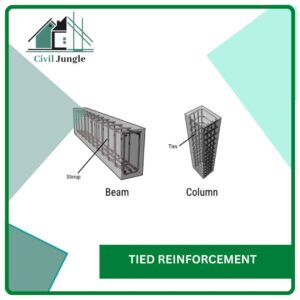
- In case of the tied reinforcement for compression member the following criteria should be conform
- In case of the tied column the ties must be located not more than half a tie spacing above the floor for footing and it no more than half a tie spacing below the lowest horizontal reinforcement in the slab.
- Tied columns are the main structural members to confine the masonry wall in order to increase the horizontal as well as vertical load-bearing capacity.
- Tied reinforcement should be arranged in such a way that every corner and alternate longitudinal bar should have lateral support provided by the corner of ties.
- Wherever the beams all bracket provided concrete confinement at the top of the column on all four sides, the top tier should be within 75 mm of the lowest horizontal Reinforcement.
Tied Brick Column

- The Tied brick columns are widely used in the construction because of its Architectural Beauty. This type of columns can be used at corner pillars, porch columns, boundary gate pillars etc.
- The construction of the side brick column is very easy and fast and also economical.
Why Spiral Column Can Sustain More Load Compared to the Tied Column?
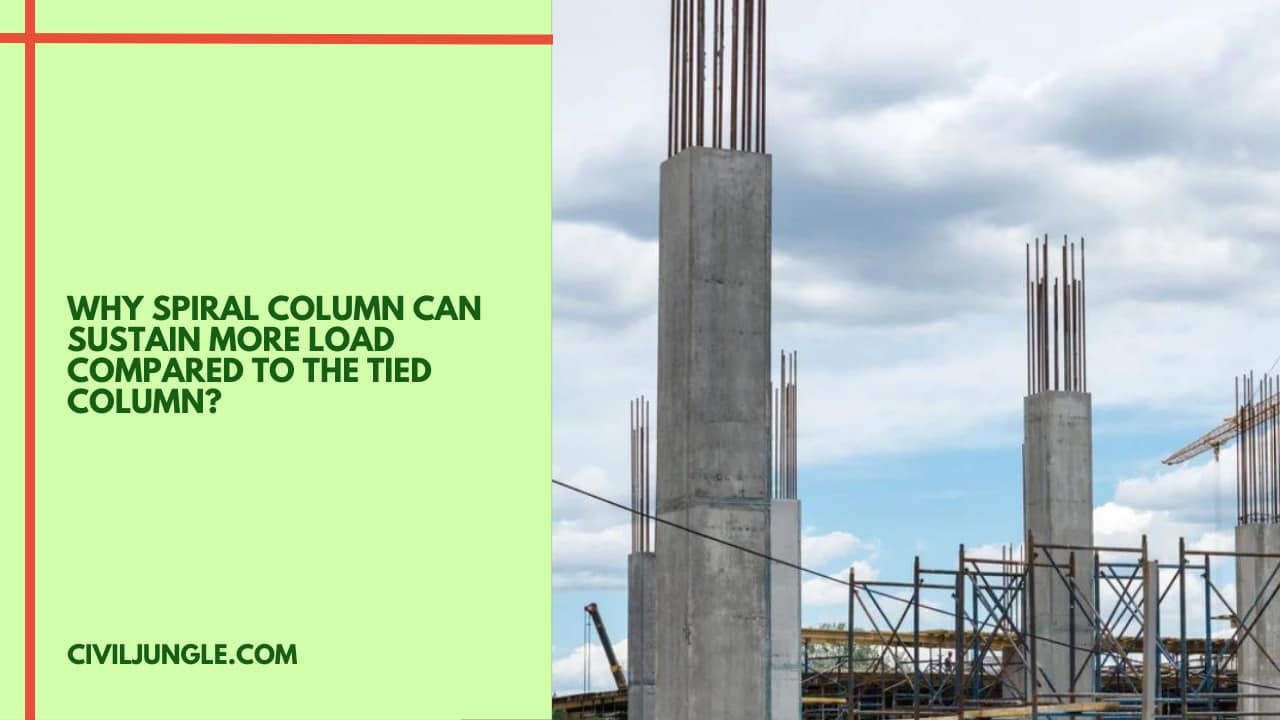
- The Reinforced cement concrete columns which are constructed with spiral reinforcement had more load-bearing capacity as compared to the tied column.
- The main function of ties and spirals in the column is only to resist the shear force in the columns.
- Spiral column has greater toughness and ductility as compared to the columns with ties.
- In the case of the Earthquake-prone Areas, the spiral columns are better than the tied columns because the spiral Reinforcement columns can transfer the energy in the continuity.
- Spiral columns had greater resistance to the vibrational forces so that they had less prone to breaking.
- It is always recommended by the structural engineers to construct the spiral reinforcement columns in the earthquake zones.
Difference Between Tied Column and Spiral Column
| Sr.No. | Tied Column | Spiral Column |
| 1 | Tied column provide less load-bearing capacity as compared to the spiral column. | Spiral column provides greater load-bearing capacity. |
| 2 | Tied columns are not suitable for the construction in the earthquake-prone areas. | Spiral columns are suitable for the construction in the earthquake-prone areas. |
| 3 | Tied columns as list ductility and flexibility as compared to the spiral column. | Spiral reinforcement has more flexibility and ductility. |
| 4 | Tied column failed suddenly due to excessive cracking in the concrete section | Spiral column can sustain large deformations before the final collapse. |
| 5 | Tied column fails suddenly due to excessive loads. | Spiral column shows deformation or indication before the complete failure. |
| 6 | The lateral reinforcement is provided in the form of helical hoops. | The lateral reinforcement is provided in the form of ties. |
FAQ: Spiral Columns vs. Tied Columns
What Is a Spiral Column?
A spiral column is a type of reinforced concrete column where continuous helical bars, known as spiral reinforcement, are wrapped around the column. This design helps to improve the column’s ductility and load-bearing capacity by providing lateral support and confinement to the concrete.
What Is a Tied Column?
A tied column is a concrete column where the longitudinal reinforcement bars are held together with smaller diameter transverse bars, called ties, spaced at regular intervals along the height of the column. This setup ensures the stability of the longitudinal bars and helps resist buckling.
How Do Spiral Columns and Tied Columns Differ in Terms of Load-Bearing Capacity?
Spiral columns generally offer greater load-bearing capacity compared to tied columns. The spiral reinforcement provides enhanced confinement and resistance to lateral forces, leading to improved performance under high loads.
Why Are Spiral Columns Preferred in Earthquake-Prone Areas?
Spiral columns are preferred in earthquake-prone areas because they exhibit greater toughness, ductility, and resistance to vibrational forces. The spiral reinforcement allows the column to deform and absorb energy more effectively, reducing the risk of sudden failure during an earthquake.
What Are the Main Advantages of Using Spiral Columns Over Tied Columns?
Spiral columns offer several advantages, including:
- Greater load-bearing capacity
- Enhanced ductility and flexibility
- Improved performance in earthquake-prone areas
- Ability to sustain large deformations before failure
How Do Tied Columns Fail Compared to Spiral Columns?
Tied columns typically fail suddenly due to excessive cracking or buckling of the longitudinal bars, often resulting from high loads. In contrast, spiral columns show deformation and provide warning signs before complete failure, allowing for potential remedial measures.
What Are the Typical Applications of Spiral and Tied Columns?
Spiral columns are often used in structures requiring high ductility and strength, such as in seismic regions or high-load applications. Tied columns are commonly used in standard construction where high seismic performance is not a critical concern.
How Is Reinforcement Provided in Spiral Columns Versus Tied Columns?
In spiral columns, lateral reinforcement is provided in the form of helical hoops that encircle the longitudinal bars. In tied columns, lateral reinforcement is provided using discrete ties spaced along the column’s height.
What Are Spiral Brick Columns and How Are They Different from Spiral Concrete Columns?
Spiral brick columns are decorative columns made from bricks laid in a spiral pattern. They are often used for aesthetic purposes in gardens, verandahs, and other decorative applications. Unlike spiral concrete columns, spiral brick columns do not typically provide the same structural strength and load-bearing capacity.
What Is the Minimum Reinforcement Requirement for Spiral Columns?
Spiral columns should have a minimum of six reinforcement bars with a diameter not less than 12 mm. The maximum distance between longitudinal bars should not exceed 300 mm.

